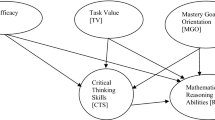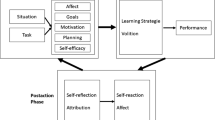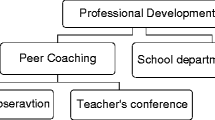Abstract
In recent years, mathematical thinking and reasoning have been widely discussed to promote students’ abilities to apply mathematical knowledge and ideas in their daily living. However, few studies have investigated the role of self-regulation in relation to reasoning. This study examined the effects of self-regulation processes on student mathematical reasoning and academic achievement. Using a quantitative research design and the PLS-SEM technique, data were collected from 248 private school students in Malaysia. The PLS-SEM results showed that behavioral regulations, including processes of self-observation, self-judgment, and self-reaction, are decisive factors in influencing student academic achievement and student mathematical reasoning ability. The dimensions of motivational regulation, including processes of self-efficacy, task value, and mastery goal orientation, are dominant factors influencing student reasoning ability, followed by cognition regulation, which includes use of elaboration strategy and critical thinking skills. The study also found that cognition regulation is a significant mediator of the relationship between motivational regulation and reasoning ability. Behavioral and cognition regulation processes, as well as students’ reasoning ability, are the mediators of motivational regulation on academic achievement. The results of this study suggest that teachers should foster the adoption of self-regulation processes in mathematics learning.


Similar content being viewed by others
References
Artino, A. R. (2005). Review of the motivated strategies for learning questionnaire. Retrieved August 23, 2017, from http://files.eric.ed.gov/fulltext/ED499083.pdf.
Azar, H. K., Lavasani, M. G., Malahmadi, E., & Amani, J. (2010). The role of self-efficacy, task value, and achievement goals in predicting learning approaches and mathematics achievement. Procedia - Social and Behavioral Sciences, 5(2), 942–947. https://doi.org/10.1016/j.sbspro.2010.07.214.
Bayat, S., & Tarmizi, R. A. (2010). Assessing cognitive and metacognitive strategies during algebra problem solving among university students. Procedia - Social and Behavioral Sciences, 8, 403–410. https://doi.org/10.1016/j.sbspro.2010.12.056.
Borich, G. D., & Tombari, M. L. (1996). Cognitive learning I: Understanding effective thinking. In Second edition Educational psychology: a contemporary approach. Harpercollins College Div. Retrieved March 20, 2017, from http://ows.edb.utexas.edu/sites/default/files/users/borichgd/book/chapter5.pdf.
Brodie, K. (Ed.). (2010). Teaching mathematical reasoning in secondary school classrooms. New York: Springer US. https://doi.org/10.1007/978-0-387-09742-8.
Danisman, S., & Erginer, E. (2017). The predictive power of fifth graders’ learning styles on their mathematical reasoning and spatial ability. Cogent Education, 4(1), 1–18. https://doi.org/10.1080/2331186X.2016.1266830.
Davadas, S. D., & Lay, Y. F. (2018). Factors affecting students’ attitude toward mathematics: A structural equation modeling approach. Eurasia Journal of Mathematics, Science and Technology Education, 14(1), 517–529. https://doi.org/10.12973/ejmste/80356.
Dent, A. L., & Koenka, A. C. (2016). The relation between self-regulated learning and academic achievement across childhood and adolescence: A meta-analysis. Educational Psychology Review, 28(3), 425–474. https://doi.org/10.1007/s10648-015-9320-8.
Duarte, P., & Amaro, S. (2018). Methods for modelling reflective-formative second order constructs in PLS: An application to online travel shopping. Journal of Hospitality and Tourism Technology. https://doi.org/10.1108/JHTT-09-2017-0092.
Fadlelmula, F. K., Cakiroglu, E., & Sungur, S. (2015). Developing a structural model on the relationship among motivational beliefs, self-regulated learning strategies, and achievement in mathematics. International Journal of Science and Mathematics Education, 13(6), 1355–1375. https://doi.org/10.1007/s10763-013-9499-4.
Hair, J. F., Hult, G. T. M., Ringle, C. M., & Sarstedt, M. (2014). A primer on partial least squares structural equation modeling (PLS-SEM). Thousand Oaks, CA: Sage.
Hair, J. F., Hult, G. T. M., Ringle, C. M., & Sarstedt, M. (2017). A primer on partial least squares structural equation modeling (PLS-SEM) (2nd ed.). Thousand Oaks, CA: Sage.
Iskender, M. (2009). The relationship between self-compassion, self-efficacy, and control belief about learning in Turkish university students. Social Behavior and Personality, 37(5), 711–720. https://doi.org/10.2224/sbp.2009.37.5.711.
Keskin, H. K. (2014). A path analysis of metacognitive strategies in reading, self-efficacy, and task value. International Journal of Social Sciences and Education, 4(4), 2223–4934. Retrieved December 25, 2017, from https://www.researchgate.net/publication/290908854_A_Path_Analysis_of_Metacognitive_Strategies_in_Reading_Self-Efficacy_and_Task_Value.
Lan, W. Y. (1996). The effects of self-monitoring on students’ course performance, use of learning strategies, attitude, self-judgment ability, and knowledge representation. The Journal of Experimental Education, 64(2), 101–115.
Latan, H. (2018). PLS path modeling in hospitality and tourism research: the golden age and days of future past. In F. Ali, S. M. Rasoolimanesh, & C. Cobanoglu (Eds.), Applying partial least squares in tourism and hospitality research (1st ed., pp. 1–35). Bingley, England: Emerald Publishing Limited. https://doi.org/10.1108/978-1-78756-699-620181004.
Li, M., Zheng, C., Liang, J. C., Zhang, Y., & Tsai, C. C. (2018). Conceptions, self-regulation, and strategies of learning science among Chinese high school students. International Journal of Science and Mathematics Education, 16(1), 69–87. https://doi.org/10.1007/s10763-016-9766-2.
Mason, L., Boscolo, P., Tornatora, M. C., & Ronconi, L. (2013). Besides knowledge: a cross-sectional study on the relations between epistemic beliefs, achievement goals, self-beliefs, and achievement in science. Instructional Science, 41(1), 49–79. https://doi.org/10.1007/s11251-012-9210-0.
Mayer, R. E. (1998). Cognitive, metacognitive, and motivational aspects of problem solving. Instructional Science, 26(1), 49–63. https://doi.org/10.1023/A:1003088013286.
Monecke, A., & Leisch, F. (2012). semPLS: Structural equation modeling using partial least squares. Journal of Statistical Software, 48(3), 1–32. https://doi.org/10.18637/jss.v048.i03.
Mousoulides, N., & Philippou, G. (2005). Students’ motivational beliefs, self-regulation strategies and mathematics achievement. In H. L. Chick & J. L. Vincent (Eds.), Proceedings of the 29th Conference of the International Group for the Psychology of Mathematics Education 3, 321–328. Melbourne: PME.
National Center for Education Statistics. (n.d.). NAEP questions tool. Retrieved January 7, 2018, from https://nces.ed.gov/NationsReportCard/nqt/.
National Council of Teachers of Mathematics. (2009). Focus in high school mathematics: Reasoning and sense making. Reston: Author.
NCTM Research Committee. (2011). Trends and issues in high school mathematics: Research insights and needs. Journal for Research in Mathematics Education, 42(3), 204–219.
Ng, B. L. L., Liu, W. C., & Wang, J. C. K. (2016). Student motivation and learning in mathematics and science: A cluster analysis. International Journal of Science and Mathematics Education, 14(7), 1359–1376. https://doi.org/10.1007/s10763-015-9654-1.
Panadero, E., & Alonso-tapia, J. (2014). How do students self-regulate? Review of Zimmerman’s cyclical model of self-regulated learning. Annals of Psychology, 30(2), 450–462. https://doi.org/10.6018/analesps.30.2.167221.
Parvin, K., Vahid, M. T., & Gholamreza, S. (1998). Relationship between self-regulated learning strategies with academic achievement: A meta-analysis. Education and Educational Technologies, 78–80.
Pintrich, P. R. (2004). A conceptual framework for assessing motivation and self-regulated learning in college students. Educational Psychology Review, 16(4), 385–407.
Pintrich, P. R., & de Groot, E. V. (1990). Motivational and self-regulated learning components of classroom academic performance. Journal of Educational Psychology, 82(1), 33–40. https://doi.org/10.1037/0022-0663.82.1.33.
Podsakoff, P. M., MacKenzie, S. B., Lee, J. Y., & Podsakoff, N. P. (2003). Common method biases in behavioral research: A critical review of the literature and recommended remedies. Journal of Applied Psychology, 88(5), 879–903. https://doi.org/10.1037/0021-9010.88.5.879.
Ramdass, D., & Zimmerman, B. J. (2008). Effects of self-correction strategy training on middle school students’ self-efficacy, self-evaluation, and mathematics division learning. Journal of Advanced Academics, 20(1), 18–41.
Rashid, R. A., & Hashim, R. A. (2008). The relationship between critical thinking and language proficiency of Malaysian undergraduates. In EDU-COM International Conference (pp. 19–21). Retrieved December 25, 2017, from http://ro.ecu.edu.au/cgi/viewcontent.cgi?article=1035&context=ceducom
Ringle, C. M., Wende, S., & Becker, J.-M. (2015). SmartPLS 3. Boenningstedt, Germany: SmartPLS GmbH. Retrieved September 27, 2018, from http://www.smartpls.com.
Schoenfeld, A. H. (2016). Research in mathematics education. Review of Research in Education, 40(1), 497–528. https://doi.org/10.3102/0091732X16658650.
Tee, K. N., Leong, K. E., & Abdul Rahim, S. S. (2018) The mediating effects of critical thinking skills on motivation factors for mathematical reasoning ability. The Asia-Pacific Education Researcher, 27(5), 373–382. https://doi.org/10.1007/s40299-018-0396-z
Velayutham, S., & Aldridge, J. M. (2013). Influence of psychosocial classroom environment on students’ motivation and self-regulation in science learning: A structural equation modeling approach. Research in Science Education, 43(2), 507–527. https://doi.org/10.1007/s11165-011-9273-y.
Verawati, Arifin, S. R., Idris, R., & Hamid, N. A. A. (2010). Gender analysis of MyCT (Malaysian critical thinking) instrument. Procedia - Social and Behavioral Sciences, 7(2), 70–76. https://doi.org/10.1016/j.sbspro.2010.10.011.
Vogt, C. M., Hocevar, D., & Hagedorn, L. S. (2007). A social cognitive construct validation: Determining women’s and men’s success in engineering programs. The Journal of Higher Education, 78(3), 337–364.
Weinstein, C. E., Husman, J., & Dierking, D. R. (2000). Self-regulation interventions with a focus on learning strategies. In M. Boekaerts, P. R. Pintrich, & M. Zeidner (Eds.), Handbook of self-regulation (pp. 727–747). San Diego, CA: Academic Press. https://doi.org/10.1016/B978-012109890-2/50051-2.
Wilson, J. E., & Weinstein, C. E. (1989). Identifying and evaluating potential instructional components for high school learning strategies programs. The High School Journal, 72(3), 136–142.
Wu, P. H. (2005). Examining the effects of self-regulated learning on junior high school students’ academic performance using structural equation modeling. National Taiwan University of Science and Technology. Retrieved August 23, 2017, from http://ir.csu.edu.tw/bitstream/987654321/603/1/20100520021.pdf.
Yang, K.-L. (2012). Structures of cognitive and metacognitive reading strategy use for reading comprehension of geometry proof. Educational Studies in Mathematics, 80(3), 307–326. https://doi.org/10.1007/s10649-011-9350-1.
Zimmerman, B. J. (1989). A social cognitive view of self-regulated academic learning. Journal of Educational Psychology, 81(3), 329–339.
Zimmerman, B. J. (2002). Becoming a self-regulated learner: An overview. Theory Into Practice, 41(2), 64–70. https://doi.org/10.1207/s15430421tip4102_2.
Author information
Authors and Affiliations
Corresponding author
Rights and permissions
About this article
Cite this article
Tee, K.N., Leong, K.E. & Abdul Rahim, S.S. A Self-Regulation Model of Mathematics Achievement for Eleventh-Grade Students. Int J of Sci and Math Educ 19, 619–637 (2021). https://doi.org/10.1007/s10763-020-10076-8
Received:
Accepted:
Published:
Issue Date:
DOI: https://doi.org/10.1007/s10763-020-10076-8




